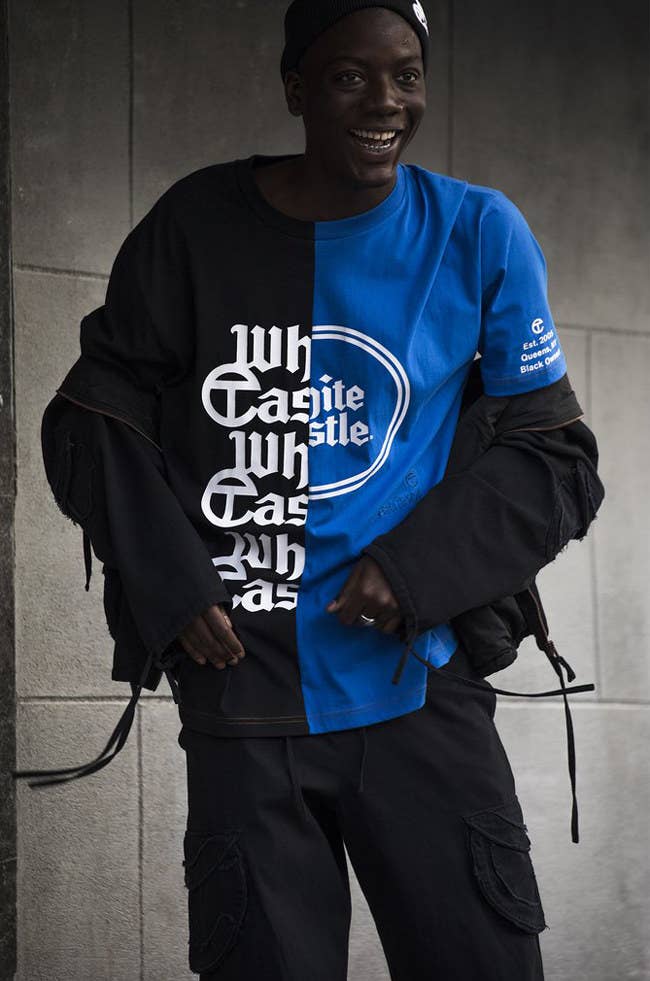Recognizing Clothes: The Importance of Fabric Selections in Your Closet
The selection of textile in apparel plays a critical role in both aesthetics and performance. Various materials supply differing levels of comfort, breathability, and toughness, directly influencing the user's experience. Recognizing these subtleties can boost one's wardrobe noticeably. Yet, several forget exactly how these selections can affect not just personal design, however also sustainability. What textile decisions could redefine your closet and align it with both design and duty?
The Duty of Material in Style and Performance

Usual Material Types and Their Qualities
When picking clothes, comprehending the qualities of common textile types is essential for making educated options. Cotton, a widely-used all-natural fiber, is known for its convenience, breathability, and soft qualities, making it suitable for laid-back wear and everyday garments. Linen, another natural alternative, flaunts outstanding moisture-wicking residential or commercial properties and a distinctive structure, ideal for warm climates.Wool, commonly favored for its warmth and durability, varies in fineness; merino woollen is soft versus the skin, while coarser types are utilized for outerwear. Synthetic materials like polyester and nylon supply durability and resistance to wrinkles, making them popular for activewear and travel garments. Blends, which incorporate artificial and natural fibers, can boost functionality while keeping convenience. By identifying these fabric features, people can pick clothes that lines up with their way of living and aesthetic preferences.
Breathability and Comfort: Picking the Right Fabrics for Different Climates
Selecting the appropriate materials for various environments can greatly boost comfort and general wearability. Breathable products are necessary in warm environments, as they allow air circulation and moisture evaporation. Fabrics such as cotton, bed linen, and moisture-wicking synthetics properly draw sweat away from the body, maintaining the user cool and completely dry. Conversely, in chillier climates, thicker materials like woollen or fleece supply insulation while maintaining breathability, ensuring heat without overheating.Additionally, the option of textile weight plays an important role; light-weight fabrics are more effective for summer season, whereas much heavier choices are matched for winter wear. Understanding the unique buildings of each material allows people to clothe suitably for varying weather conditions. Ultimately, picking comfortable and breathable textiles customized to particular environments can considerably improve everyday convenience and improve the overall experience of using apparel.
Longevity and Care: How Material Affects Long Life of Your Wardrobe
Choosing the best materials can considerably impact the resilience and treatment needs of a wardrobe. Fabrics such as cotton and polyester are known for their strength and convenience of maintenance, making them perfect for day-to-day wear. In comparison, delicate products like silk and shoelace need more careful handling and specialized cleaning methods, which can boost the moment and initiative required for care. Branded Clothing.Durability is additionally influenced by the textile's weave and coating; snugly woven textiles often tend to stand up to damage better than freely woven alternatives. Furthermore, artificial blends often supply enhanced longevity, incorporating the very best qualities of multiple fibers.Understanding the care directions for each and every textile is crucial, as incorrect cleaning or drying out can bring about early wear. Ultimately, picking durable products can bring about a longer-lasting closet, lowering the frequency of substitutes and adding to an extra lasting fashion selection
The Influence of Fabric on Fit and Silhouette

Sustainable Textile Choices: Making Eco-Friendly Choices
The impact of material extends beyond fit and silhouette to include environmental factors, triggering a growing passion in lasting fabric choices. Eco-friendly materials, such as natural cotton, hemp, and Tencel, are getting grip amongst consumers who focus on sustainability in their closets. These materials are frequently produced with less chemicals and water, decreasing their eco-friendly footprint.Additionally, recycled fabrics, made from post-consumer waste, supply a cutting-edge solution to the textile industry's pollution problem. Brands progressively welcome transparency in their sourcing methods, permitting customers to make informed choices about their purchases.Choosing sustainable fabrics not just sustains moral methods however likewise urges the garment industry to embrace even more liable manufacturing methods. As understanding of ecological issues climbs, individuals are prompted to assess the lasting impact of their textile selections, cultivating an activity towards a more ecologically conscious and lasting strategy to fashion.
Elevating Style: Just How Material Can Change an Attire
While several might concentrate on shade and cut when picking an outfit, the option of material plays a crucial function in raising style and enhancing total look. Various products share distinctive moods and messages; as an example, silk exhibits deluxe and class, while jeans uses a casual, unwinded ambiance. The appearance and drape of a fabric can considerably modify the shape, with structured textiles offering a refined appearance and softer ones developing an extra fluid, loosened up aesthetic.Moreover, the weight of the textile influences wearability throughout periods. Lightweight fabrics like linen More Bonuses and cotton are suitable for summertime, while heavier products such as woollen and velvet provide heat and sophistication in cooler months. Understanding fabric buildings, such as breathability and stretch, also empowers individuals to make enlightened options that improve comfort without endangering style. Ultimately, the best material can transform a clothing from average to phenomenal, making it an important consideration in any type of wardrobe.
Often Asked Concerns
Exactly how Do I Determine the Textile Web Content of My Apparel?
To identify material web content, one can analyze care tags, conduct shed tests for fiber identification, or seek advice from material swatches. These approaches assist set apart products, making sure informed selections for garments care and maintenance in day-to-day wear.
Can Material Choice Affect My State Of Mind or Self-confidence?
Fabric choice can considerably impact an individual's state of mind and self-confidence. Branded Clothing. Specific products may evoke sensations of convenience or sophistication, while others can really feel restrictive or unflattering, eventually influencing self-perception and psychological well-being throughout the day
What Fabrics Are Finest for Delicate Skin?
For people with sensitive skin, natural fabrics like cotton, bed linen, and bamboo are usually suggested. These materials are breathable, hypoallergenic, and less likely to create irritability, making them suitable choices for comfort and skin health.
Exactly how Do I Properly Laundry and Treatment for Different Fabrics?
To correctly care and clean for different materials, one must take into consideration each material's certain requirements, consisting of temperature level settings, cleaning agents, and drying out methods, making certain long life and preserving the textile's original high qualities for suitable usage.
Exist Certain Fabrics for Athletic or Performance Wear?
Athletic or performance wear often makes use of textiles such as nylon, polyester, and spandex. These materials are developed for moisture-wicking, breathability, and adaptability, boosting activity and comfort during exercises while providing longevity and support. Alternatively, in cooler environments, thicker materials like wool or fleece offer insulation while maintaining breathability, guaranteeing heat without overheating.Additionally, the selection of textile weight plays an important duty; lightweight fabrics are preferable for summer season, whereas larger choices are matched for wintertime wear. In contrast, fragile materials like silk and shoelace call for even more mindful handling and specialized cleansing approaches, which can boost the time and effort required for care.Durability is additionally influenced by the fabric's weave and finish; snugly woven textiles tend to withstand wear and tear far better than freely woven choices. In contrast, rigid textiles can limit movement yet give a classic, polished look.Moreover, the thickness and structure of the fabric can influence the aesthetic perception of body form. The effect of fabric extends beyond fit and shape to include environmental elements, motivating a growing rate of interest in lasting textile selections. The structure and drape of a material can drastically change the shape, with structured fabrics giving a polished look and softer ones developing a more fluid, kicked back aesthetic.Moreover, the weight of the fabric influences wearability across periods.